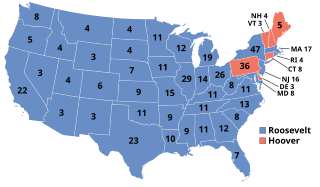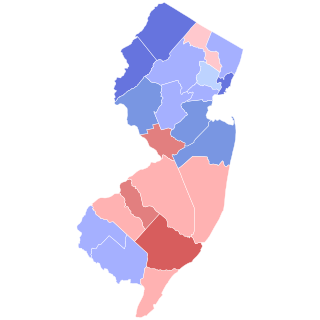
Presidential elections were held in the United States on November 8, 1932. Against the backdrop of the Great Depression, incumbent Republican President Herbert Hoover was defeated in a landslide by Democrat Franklin D. Roosevelt, the governor of New York and the vice presidential nominee of the 1920 presidential election. The election marked the effective end of the Fourth Party System, which had been dominated by Republicans, and it was the first time since 1916 that a Democrat was elected president.

John William Griggs was an American lawyer and Republican Party politician who served as the 29th Governor of New Jersey from 1896 to 1898 and the 43rd United States Attorney General from 1898 to 1901.

The 1908 Republican National Convention was held in Chicago Coliseum, Chicago, Illinois on June 16 to June 19, 1908. It convened to nominate successors to President Theodore Roosevelt and Vice President Charles W. Fairbanks.

Franklin Murphy was an American Republican Party politician, who served as the 31st governor of New Jersey, from 1902 to 1905. He was the founder of the Murphy Varnish Company in Newark, New Jersey.

James Madison Seymour was the mayor of Newark, New Jersey, from January 1, 1896, to January 1, 1903.
Edward E. Gnichtel was a New Jersey businessman and Republican Party politician who represented Essex County in the New Jersey General Assembly.

The 1981 New Jersey gubernatorial election was held November 3, 1981. Republican Speaker of the New Jersey General Assembly Thomas Kean narrowly defeated Democratic U.S. Representative James Florio, 49.46%-49.38, following a recount. Kean's margin of victory was 1,797 votes out of more than two million votes cast. As of 2025, the 1981 gubernatorial election remains the closest gubernatorial contest in New Jersey history.

The 1943 New Jersey gubernatorial election was held on November 2, 1943. Republican nominee Walter Evans Edge defeated Democratic nominee Vincent J. Murphy with 55.20% of the vote.

The 1913 New Jersey gubernatorial election was held on November 4, 1913. Democratic acting Governor James Fairman Fielder, who resigned a week before the election so that he could succeed himself, defeated Republican former Governor Edward C. Stokes and Progressive former state senator Everett Colby.

The 1910 New Jersey gubernatorial election was held on November 8, 1910. Democratic nominee and future President Woodrow Wilson defeated Republican Assemblyman Vivian M. Lewis with 53.93% of the vote. During the campaign, Wilson underwent a political transformation from a symbol of conservative Wall Street reaction into one of the leading members of his party's progressive faction. His victory was widely understood to be the prelude to his campaign for the presidency in 1912.

The 1907 New Jersey gubernatorial election was held on November 5, 1907. Republican nominee John Franklin Fort defeated Democratic nominee Frank S. Katzenbach with 49.28% of the vote.

The 1904 New Jersey gubernatorial election was held on November 8, 1904. Republican nominee Edward C. Stokes defeated Democratic nominee Charles C. Black with 53.50% of the vote.

The 1898 New Jersey gubernatorial election was held on November 8, 1898. Republican nominee Foster McGowan Voorhees defeated Democratic nominee Elvin W. Crane with 48.91% of the vote.

The 1895 New Jersey gubernatorial election was held on November 5, 1895. Republican nominee John W. Griggs defeated Democratic nominee Alexander T. McGill with 52.28% of the vote.

The 1859 New Jersey gubernatorial election was held on November 8, 1859. Opposition Party nominee Charles Smith Olden defeated Democratic nominee Edwin R. V. Wright with 50.76% of the vote.

The 1856 New Jersey gubernatorial election was held on November 4, 1856. William A. Newell, running on a fusion ticket opposed to the Franklin Pierce administration, defeated Democratic nominee William Cowper Alexander with 51.29% of the vote.

Frank Snowden Katzenbach, Jr. was an American jurist and Democratic party politician from New Jersey. He was an Associate Justice of the New Jersey Supreme Court and was the Democratic nominee for Governor of New Jersey in 1907. He was the brother of New Jersey Attorney General Edward L. Katzenbach and uncle of Nicholas Katzenbach, the United States Attorney General.

The United States Senate election of 1916 in New Jersey was held on November 7, 1916.

The 1911 United States Senate election in New Jersey was held on January 24–25, 1911. Republican incumbent John Kean did not run for re-election to a third term. The open seat was won by Democrat James Edgar Martine with Republican former Governor Edward C. Stokes as the runner-up.

The 1983 New Jersey Senate election was held on November 8.






















